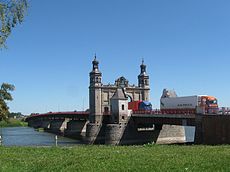Lithuania–Russia border
| Lithuania–Russia border | |
|---|---|
 | |
| Characteristics | |
| Entities | Lithuania Russia |
| Length | 227km |
| History | |
| Established | After World War I |
The Lithuania–Russia border is an international border between the Kaliningrad Oblast, an exclave of the Russian Federation (CIS member) and Republic of Lithuania (EU member). The 227 kilometres (141 mi) long border passes (from west to south-east clockwise) through the Curonian Spit and Curonian Lagoon, and then follows along the Neman River, Šešupė, Širvinta, Liepona, and Lake Vištytis. There is a tripoint between Lithuania, Russia, and Poland with a stone monument at 54°21′48″N 22°47′31″E / 54.36333°N 22.79194°E.
Most of the border follows rivers or lakes. On land, border stations are equipped with engineering and technical facilities (wired fences and the exclusion zone). Most other land areas have no fence, but some places near roads or villages have fences (e.g. at 54°27′11″N 22°42′08″E / 54.45306°N 22.70222°E with Street View coverage). Crossing the border into Lithuania requires a Schengen visa, and into Russia requires a Russian visa. In early 2017, with increasing military activity and political tensions in the area, the government announced plans to reinforce the Kaliningrad/Ramoniškiai area border crossing with a fence 6 ft (1.8 m) in height, funded by NATO, characterized by some officials as a token effort and waste of money.[1][2]
History
Historical borders between the Grand Duchy of Lithuania and Tsardom of Russia varied significantly throughout history, and at times bore little resemblance to the modern borders.
The modern Lithuanian-Russian border was established after World War I. For the most part it follows the older border between former German province of East Prussia to the south with Russia to the north. In 1923, the Klaipėda Region (Memelland) was transferred to Lithuania, and in 1939, Lithuania was forced to return it to Germany. In 1945 the south side of the border was taken over by the Soviet Union as the Kaliningrad Oblast, and the north side as Lithuanian part of the Soviet Union Until 1991, this boundary was an internal border of the Soviet Union between the RSFSR and the Lithuanian SSR. In 1991 Russia and Lithuania were recreated as countries, making this border international again. In opposite to before 1917, Russia was now on the south side. In 1997, the Russian Federation and the Republic of Lithuania signed a border agreement, intended to reduce inconveniences of the border. For example, at Lake Vištytis the border ran along the waterline of the beaches on the Lithuanian side, so anyone paddling in the water was technically crossing into Russia. In return, Russia received the appropriate territorial compensation in other areas. The treaty entered into force in 2003.
Border crossings
| Image | Russian Road/Track Name[3] | Lithuanian Road/Track Name [3] | Type of crossing [3] | Characteristics[4] | Status [4] | Coordinates [3] |
|---|---|---|---|---|---|---|
| R515 | 167 (Nida) | Road | Active | 55°16′47″N 20°57′50″E / 55.279788°N 20.963893°E | ||
| - | (Pagėgiai) | Railway | Active | 55°05′27″N 21°53′12″E / 55.090763°N 21.886789°E | ||
| A216/E77 | A12/E77 (Panemunė) | Road | Active | 55°05′01″N 21°54′21″E / 55.083649°N 21.905818°E | ||
| 27K-105 | 184 (Ramoniškiai) | Road | Active (only for Russian and Lithuanian nationals) | 55°03′35″N 22°35′30″E / 55.059609°N 22.591793°E | ||
| P509 | Vytauto g. (Kudirkos Naumiestis) | Road | Closed | 54°46′34″N 22°51′18″E / 54.775988°N 22.855040°E | ||
| E28 | A7/E28 (Kybartai) | Road | Active | 54°38′30″N 22°44′38″E / 54.641721°N 22.743941°E | ||
| Kaliningrad Railway | (Kybartai) | Railway | Active | 54°38′24″N 22°44′49″E / 54.640051°N 22.747080°E | ||
| 27K-210 | 200 (Vištytis) | Road | Closed | 54°27′13″N 22°42′11″E / 54.453573°N 22.703110°E |
Economy
At the Russian-Lithuanian border smuggling takes place and semi-legal "shuttle" trade cheaper Russian and Belarusian products, which are exported to Lithuania for resale.[5] Especially popular are cigarettes.
External links
References
- ^ Woody, Christopher. "Lithuania is building a border fence amid Russia fears — even though it would do little to stop an invasion". Business Insider. Retrieved 17 August 2018.
- ^ Boffey, Daniel (24 August 2017). "'We know how to live next to Russia': Lithuania builds border fence with Kaliningrad". the Guardian. Retrieved 17 August 2018.
- ^ a b c d See Google Maps for respectively coordinate and OpenStreetMap.
- ^ a b See Google Street View for respectively coordinate.
- ^ "Пограничник Геннадиюс Кузнецовас: литовцы готовы умереть, чтобы заработать на российских сигаретах". NEWSru.com (in Russian). NEWSru.
